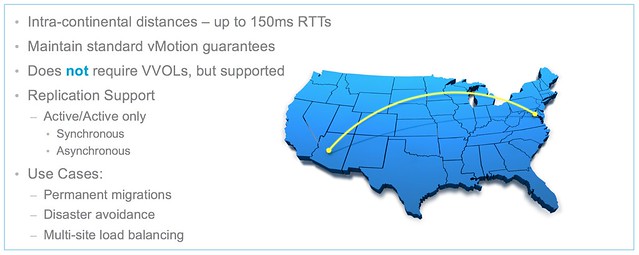Having seen so many cool features being released over the last 10 years by VMware you sometimes wonder what more they can do. It is amazing to see what level of integration we’ve see between the different datacenter components. Many of you have seen the announcements around Long Distance vMotion support by now.

When I saw this slide something stood out to me instantly and that is this part:
- Replication Support
- Active/Active only
- Synchronous
- Asynchronous
- Active/Active only
What does this mean? Well first of all “active/active” refers to “stretched storage” aka vSphere Metro Storage Cluster. So when it comes to long distance vMotion some changes have been introduced for sync stretched storage. (** note that “active/active” storage is not required for long distance vMotion**)With stretched storage writes can come from both sides at any time to a volume and will be replicated synchronously. Some optimizations have been done to the vMotion process to avoid writes during switchover to avoid any delay during the process as a result of replication traffic.
For active/active asyncronous the story is a bit different. Here again we are talking about “stretched storage” but in this case the asynchronous flavour. One important aspect which was not mentioned in the deck is that async requires Virtual Volumes. Now, at the time of writing there is no vendor yet who has a VVol capable solution that offers active/active async. But more important, is this process any different than the sync process? Yes it is!
During the migration of a virtual machine which uses virtual volumes, with an “active/active async” configuration backing it, the array is informed that a migration of the virtual machine is taking place and is requested to switch from asynchronous replication to synchronous. This to ensure that the destination is in-sync with the source when the VM is switched over from side A to side B. Besides switching from async to sync when the migration has completed the array is informed that the migration has completed. This allows the array to switch the “bias” of the VM for instance, especially in a stretched environment this is important to ensure availability.
I can’t wait for the first vendor to announce support for this awesome feature!
This is a really nice to have. Might be a very good used case for many stretch environment saving quite a bit on bandwidth.
Btw, is the long distance vMotion now support 150ms instead of 100ms?
Yes it is 150ms.